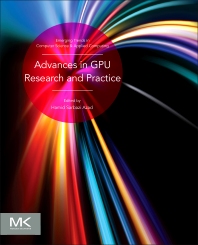Books in Hardware and architecture
Books in Hardware and architecture
Showcasing processor design, digital logic, and embedded systems, this collection provides deep insights into hardware development. Featuring the latest research, design methodologies, and practical applications, these titles support engineers, researchers, and students in creating efficient, innovative computing devices. Addressing emerging trends like quantum computing and hardware security, the collection fosters technological progress at the hardware-software interface.
- 1st Edition
- September 6, 2016
- Hamid Sarbazi-Azad
- English
- Paperback9 7 8 0 1 2 8 0 3 7 3 8 6
- eBook9 7 8 0 1 2 8 0 3 7 8 8 1

Advances in GPU Research and Practice
- 2nd Edition
- June 6, 2016
- Trevor Martin
- English
- Paperback9 7 8 0 0 8 1 0 0 6 2 9 0
- eBook9 7 8 0 0 8 1 0 0 6 3 4 4

The Designer's Guide to the Cortex-M Processor Family
- 1st Edition
- April 27, 2016
- Larry D Pyeatt
- English
- Hardback9 7 8 0 1 2 8 0 3 6 9 8 3
- eBook9 7 8 0 1 2 8 0 3 7 1 6 4

Modern Assembly Language Programming with the ARM Processor
- 1st Edition
- March 25, 2016
- Jacob Murray + 3 more
- English
- Paperback9 7 8 0 1 2 8 0 3 6 2 5 9
- eBook9 7 8 0 1 2 8 0 3 6 5 1 8

Sustainable Wireless Network-on-Chip Architectures
- 1st Edition
- December 4, 2015
- Hua Wang + 1 more
- English
- Hardback9 7 8 0 1 2 4 0 8 0 5 2 2
- eBook9 7 8 0 1 2 4 0 9 5 2 2 9

RF and mm-Wave Power Generation in Silicon
- 1st Edition
- November 17, 2015
- Sanjeeb Mishra + 2 more
- English
- Paperback9 7 8 0 1 2 8 0 1 6 3 0 5
- eBook9 7 8 0 1 2 8 0 1 7 9 0 6

System on Chip Interfaces for Low Power Design
- 1st Edition
- September 3, 2015
- Jason D. Bakos
- English
- Paperback9 7 8 0 1 2 8 0 0 3 4 2 8
- eBook9 7 8 0 1 2 8 0 0 4 1 2 8

Embedded Systems
- 2nd Edition
- June 15, 2015
- Joseph Yiu
- English
- Paperback9 7 8 0 1 2 8 0 3 2 7 7 0
- eBook9 7 8 0 1 2 8 0 3 2 7 8 7

The Definitive Guide to ARM® Cortex®-M0 and Cortex-M0+ Processors
- 1st Edition
- April 9, 2015
- Sarah Harris + 1 more
- English
- Paperback9 7 8 0 1 2 8 0 0 0 5 6 4
- eBook9 7 8 0 1 2 8 0 0 9 1 1 6

Digital Design and Computer Architecture, ARM Edition
- 6th Edition
- March 3, 2015
- William Bolton
- English
- Paperback9 7 8 0 1 2 8 0 2 9 2 9 9
- eBook9 7 8 0 0 8 1 0 0 3 5 3 4

Programmable Logic Controllers